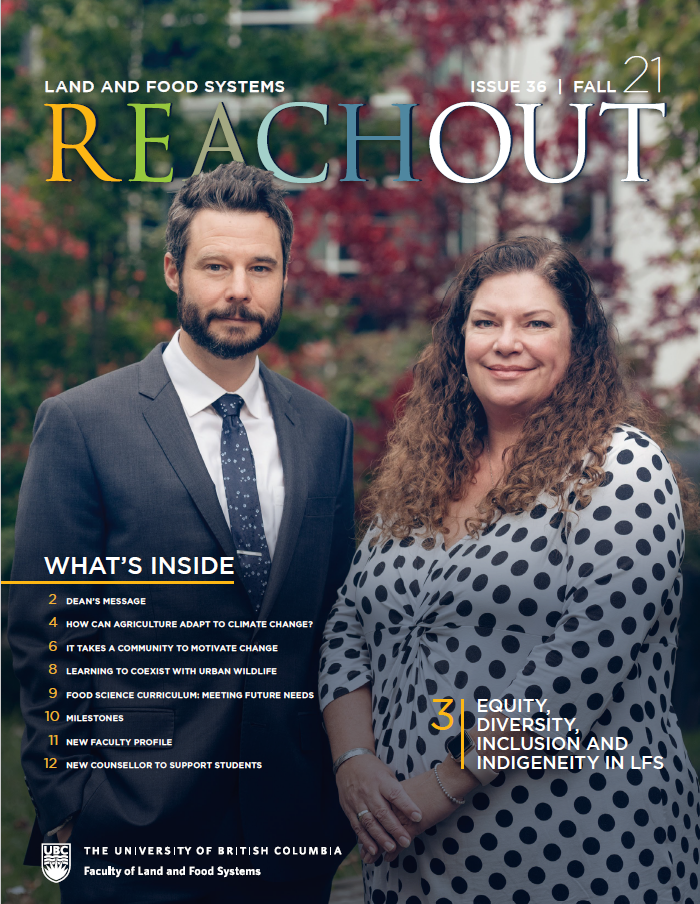How Can Agriculture Adapt to Climate Change?
This summer saw unprecedented climate events in regions around the world. Canada set an all-time record high temperature when Lytton, B.C., broke the heat record for three consecutive days in June, peaking at 49.6° C. What does this mean for agriculture? We asked some LFS faculty members to share ideas based on their research expertise.

Andrea Frommel, Assistant Professor and Chair of Sustainable Aquaculture
Research area: Bridging climate change, fisheries and sustainable aquaculture, with a focus on early life stages of finfish.
“A major way in which finfish aquaculture can adapt to climate change is to move from open farming to land-based, closed-containment systems. This allows farmers to control the main water parameters impacted by climate change – temperature, oxygen and pH – and avoid secondary climate change effects such as harmful algal and jellyfish blooms, providing an optimal rearing environment for their fish. Further, closed-containment systems significantly reduce the impact of aquaculture on the environment and wild stocks. Another option is to farm species that are climate friendly and sustainable, such as shellfish and kelp.”

Andy Black, Professor
Research area: Studying the effects of climate variability and disturbance on the carbon and water cycles in forests, wetlands and agricultural fields in Western Canada.
“Over the last five years we have studied the use of plastic-film mulches and transparent plastic-film low tunnels for improving vegetable microclimate and productivity in response to climate change. We have shown that under increasing warming and droughts, high reflectivity plastic mulches cool the soil in summer, dark-coloured mulches warm the soil in early spring enabling growers to start their crops earlier, and all plastic mulches conserve soil moisture. Also, plastic-film low tunnels protect against spring and fall frosts as farmers avoid growing crops in the heat of the summer.”

Andrew Riseman, Associate Professor
Research area: Understanding the role of plant genetics in the design of sustainable production systems, identifying relevant traits useful in these systems, and combining and integrating them within superior germplasm in an optimized system.
“The role of plant genetics in both adapting to and helping mitigate the impacts of climate change is critical. Two of the traits I’ve worked with include the ability to use nitrogen efficiently in grain crops (e.g., producing more yield with less synthetic nitrogen) and the ability to share nitrogen in complex crop mixtures (i.e., one plant fixes atmospheric nitrogen and ’shares’ it with a companion plant). Both of these traits help address climate change by reducing the energy needed to grow crops through reducing synthetic nitrogen manufacturing and use.”

Hannah Wittman, Professor
Research area: Rural and environmental sociology, agrarian citizenship and political economy, food security and food sovereignty, community and rural development, social movements.
“Climate change is presenting devastating risks to agriculture, and these risks are not equally distributed. Our research has shown that agroecological farming systems are more climate resilient, while also supporting food security, sustainable livelihoods, and the provision of important ecological services. Why, then, are farms becoming larger and more homogenized? Our group uses interdisciplinary and complex systems approaches to understand trade-offs between livelihoods, biodiversity/food security outcomes, and constraints related to farm size, land tenure, and the inequitable distribution of resources and power.”

Jean-Thomas Cornelis, Assistant Professor
Research area: Impact of human behavior on soils – sustainably managing ecosystems by increasing the resistance and resilience of soil-plant systems while decreasing human-induced pressures on the environment.
“Climate change is placing plants under a series of stresses. But plants have more than one string at their bow. For instance, plants can cope with drought by increasing the release of organic molecules at the soil-root interface, which sustains nutrient acquisition while enhancing soil carbon sequestration. However, the benefits of these mechanisms are dependent on soil properties. Therefore, considering soil constituents and processes is vital for understanding plant responses to climate change.”

Risa Sargent, Associate Professor
Research area: Exploring how plants and their biotic communities (e.g., pollinators and herbivores), especially those in agroecosystems, are adapting to the significant pressures associated with global change.
“Climate change is a critical challenge for agriculture. Predictions include the northward migration of pest species, longer periods of drought and more rainfall and flooding. My research focuses on habitat restoration for preserving and enhancing species interactions in ecological communities. I primarily address the biodiversity crisis, but my work also has implications for climate adaptation. For example, enhancing on-farm habitat can improve carbon sequestration, provide shade for animals and promote natural pest control. It is very important to focus our attention on reducing global carbon emissions as our ability to adapt agricultural systems to climate change is essentially unknown.”

Juli Carrillo, Assistant Professor
Research area: How elevated carbon dioxide levels impact the ability of vegetable and fruit crops to defend themselves against insect herbivores.
“It is critically important to better understand how climate change is changing important species interactions in agroecosystems. One concern is that pests may become more abundant and cause more damage to crops because of changes to crop nutritional quality and plant defensive compounds. Changes in crop-pest interactions can flow through agroecological food webs to influence beneficial insects at higher trophic levels and microbial soil organism at lower trophic levels. We are currently evaluating how changes in CO2 may inhibit the ability of crop plants to produce compounds that attract the natural enemies of pest insects, and defend themselves directly through the production of anti-herbivory toxins.”

Sean Smukler, Associate Professor and Chair of Agriculture and the Environment
Research area: Working with farmers, and other managers of agricultural landscapes to find ways to better monitor, protect and enhance biodiversity and the availability of ecosystem services.
“To adapt to a changing climate, we need to improve the resiliency of our farms as soon as possible. This starts with building and maintaining healthy soil. We can help by providing farmers a better understanding of how to use technology and data to apply agroecological practices to improve their soil.”

Maja Krzic, Associate Professor Applied Biology/Forest and Conservation Sciences
Research area: Combining soil science concepts and the impact of humans on soil properties and processes in crop, grassland, and forest ecosystems; exploring the role of soil in addressing some of the existential global sustainability challenges we are facing.
An estimated 30% of the global terrestrial carbon pool is found in grassland soils, making them of particular interest for research focused on climate change impacts. Grasslands of the Southern Interior of British Columbia offer numerous opportunities to study carbon sequestration. For example, one of our recent studies found that even though previously degraded grasslands have experienced a notable plant species recovery over a period of 58 years, that was not accompanied by a change in soil carbon stocks, emphasizing the fact that recovery of the degraded grassland soils is indeed a very slow process.

Thorsten Knipfer, Assistant Professor
Research area: Plant physiology – proactively addressing stress physiology that significantly contributes to the success of agricultural practices in water-stressed environments.
“Agriculture in Canada faces unprecedented challenges caused by drought due to ongoing climate change. Applying precision irrigation and sustainable agricultural practices through water savings is an area of interest, as these are tightly linked to our knowledge about drought stress responses in crops. We are currently evaluating the physiological performance of hazelnut, poplar, and wheat under drying soil conditions. We were able to explain the genotype-specific thresholds of stomatal closure, turgor loss and xylem embolism susceptibility. We are using this information to disentangle the sequence of drought-induced physiological events and establish new targets for water management for B.C. farmers.”
